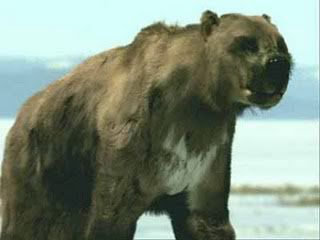Captive polar/grizzly bear hybrid follow up:Some of you are familiar with the following older BBC article....
Polar bear plus grizzly equals?
Clockwise: A female hybrid, male hybrid, polar bear and brown bear
(all pictures courtesy of Alexandra Preuß).
What do you get if you cross a polar bear with a grizzly brown bear?
Scientists can now answer the question, following the first study of a polar bear/grizzly bear hybrid.
Only one hybrid bear has ever been seen in the wild, so the study evaluated two hybrid bears kept in captivity, which are among 17 such bears known to exist.
While each hybrid has inherited characteristics from either parent, some traits, such as partially hollow hair, appear to be a blend of the two.
"Hybrids between polar and brown bears in the wild are very rare. Only one confirmed case is known," says Dr Ute Magiera, the conservation coordinator of Osnabruck Zoo in Germany.
That hybrid bear was shot in April 2006 by an American big game hunter on Banks Island, Northwest Territories, Canada.
However, a small number of hybrid bears do exist in zoos in the Czech Republic, Israel, Russia, Spain, Poland and Germany as a result of grizzly bears, a subspecies of brown bear, and polar bears being held in the same enclosures.
At Osnabruck Zoo, for example, both species were kept together since 1980, producing no offspring.
Then in January 2004, a female brown bear gave birth to two brown/polar bear hybrids at the zoo.
"We were surprised about the offspring, because for 24 years nothing happened," says Dr Magiera.

Spot the hybrid: From left to right, female hybrid, male hybrid,
polar bear and brown bear.
Soon after their birth, the hybrids were moved to another zoo, preventing them from learning any behaviours from either parent.
Now Dr Magiera, Dr Alexandra Preuß of the University of Osnabruck and Osnabruck Zoo and colleagues have published details of the hybrid bears in the scientific journal Der Zoologische Garten.
Physically, the hybrids have a range of characteristics.
In terms of overall size, they fall between the larger polar bear and slightly smaller grizzly.
They have longer necks more typical of polar bears, but also display small shoulder humps reminiscent of brown bears.
The size and shape of their heads is intermediate between the thicker-set brown bear and more slender-headed polar bear.
Hybrids have visible tails, like polar bears, whereas those of brown bears are barely apparent.
The bears' feet are also an intriguing blend.
The soles of the hybrids' feet are partially covered in hair. Polar bear feet are covered in hair to insulate them from the ice, whereas brown bears have hairless soles and clearly visible toes.
But most intriguing is the bears' hair.
When viewed as a cross section, the shaft of a brown bear's hair is either solid or full of small hollow regions, depending on where the hair is on the bear's body.
The hair of a polar bear is almost completely hollow, with large empty regions within its core.

The shaft of the hair from a hybrid bear has hollow pockets, compared
with the hollow shaft of polar bear hair, and closed shaft of brown bear hair.
The hair of the hybrid bears display a blend of both.
Hair on the paw of the male hybrid is solid. But dark hair on the male's back is hollow, but with smaller empty regions than found in polar bear hair.
The hair on the female contains a range of hollow regions.
Behaviourally, the two hybrids have much in common with polar bears.
When given large toys to play with, such as tractor wheels or barrels, both bears used their front legs to stamp on the object, just as polar bears stamp onto ice to break through to seal dens.

Hybrid bear feet are partially covered with fur; polar bear feet are fully
covered and brown bear feet uncovered.
The hyrbids also used their teeth to hurl jute-bags from left to right, as polar bears may hurl prey. Brown bears given similar bags do not show this behaviour.
The male hybrid bear has been sterilised. But if the female proves fertile, it suggests that hybrid bears could continue to breed in the wild if their ranges overlap more, says Dr Magiera.
Brown bears (Ursus arctos) and polar bears (Ursus maritimus) split into distinct species around 200-300,000 years ago.
Generally, their modern ranges don't overlap; the brown bear is found in the montane forests of the Holarctic and tundra, while the polar bear frequents the Arctic.

Hybrid bears lie down just as polar bears do.
However, in some regions of the Canadian Arctic and Siberia, brown bears do venture on to pack ice, potential bringing them into contact with their more northerly relative.
Some experts say that global warming and diminishing ice packs will lead to polar bears spending more time on the mainland.
While some think that a few populations of polar bear may return permanently to their original mainland habitat, others say that climatic changes will happen too fast for the bears to adapt.
news.bbc.co.uk/earth/hi/earth_news/newsid_8321000/8321102.stm 

